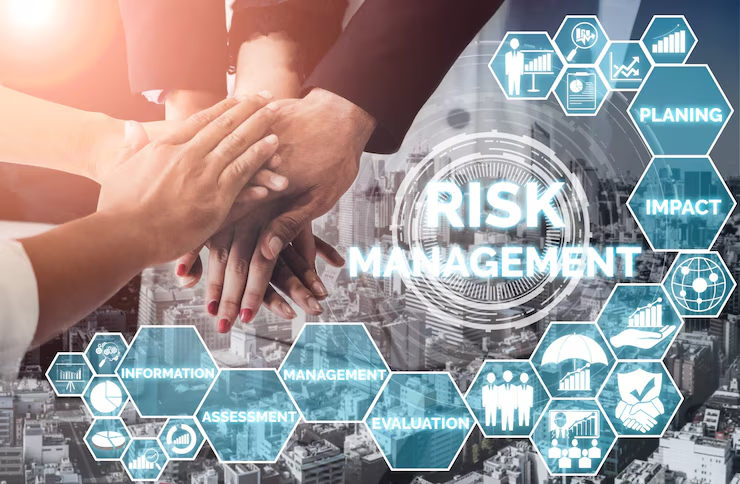Introduction
In an increasingly complex and volatile global economy. Businesses face numerous threats from cyberattacks and supply chain disruptions to market volatility and geopolitical instability. Risk Management Techniques for Business Stability. These challenges highlight the importance of risk management as a key component of business strategy. A well structured risk management approach helps businesses. Identify assess and respond to risks ensuring long term stability and sustainability.
In this article we explore the essential risk management techniques that can help businesses. Of all sizes maintain operational continuity and achieve long term stability in 2025 and beyond.
Understanding Risk Management
Risk Management
Risk management is the process of identifying analyzing and mitigating the potential threats that could adversely affect a businesss operations assets reputation or profitability. These risks may be internal (e g operational inefficiencies) or external (e g economic downturns).
Categories of Risk
- Strategic Risk Poor business decisions, lack of vision, or flawed planning.
- Operational Risk Equipment failures, human errors, or supply chain issues.
- Financial Risk Interest rate fluctuations, credit defaults, and liquidity issues.
- Compliance Risk Breaches of laws and regulations.
- Reputational Risk Negative publicity, social media backlash, or customer dissatisfaction.
- Cyber Risk Data breaches, hacking, or system outages.
The Risk Management Process
Risk Identification
Start by conducting internal audits SWOT analyses and scenario planning to identify potential risks.
Tools for risk identification
- Brainstorming sessions
- Historical data review
- Industry benchmarking
- Expert interviews
Risk Assessment
Classify risks by
- Likelihood How probable is the risk
- Impact What are the potential consequences
This stage may use a risk matrix to visualize the threat landscape.
Risk Prioritization
Focus on high impact high likelihood risks first. Create a risk register and assign owners to each threat.
Risk Mitigation
Develop response strategies such as
- Avoidance (eliminate the risk)
- Reduction (minimize the impact)
- Transfer (insurance or outsourcing)
- Acceptance (acknowledge and monitor)
Monitoring and Reviewing
Implement continuous monitoring systems update risk assessments periodically and adapt strategies to new threats.
Core Risk Management Techniques

Diversification
Avoid placing all resources or investments in one area. Diversify
- Revenue streams
- Suppliers and vendors
- Markets and customer segments
Benefit Reduces exposure to industry specific or regional downturns.
Insurance Coverage
Essential policies include
- General liability insurance
- Property insurance
- Cybersecurity insurance
- Business interruption insurance
- Professional indemnity insurance
Tip Work with a risk advisor to customize your policy portfolio.
Contingency Planning
Create business continuity and disaster recovery plans
- Backup data and IT systems
- Establish alternate supply chains
- Cross-train employees for multiple roles
Hedging and Financial Instruments
Use tools such as
- Futures contracts
- Options
- Currency swaps
These instruments protect against
- Interest rate fluctuations
- Commodity price volatility
- Exchange rate changes
Cybersecurity Protocols
With rising cyber threats businesses must
- Use firewalls and encryption
- Implement two factor authentication
- Conduct regular security audits
- Train employees on phishing and data hygiene
Legal and Regulatory Compliance
Stay updated on
- Industry-specific laws
- Employment regulations
- Environmental guidelines
- Tax obligations
Tools like compliance management software can help automate this process.
Embedding Risk Culture in the Organization

Leadership Commitment
Leadership must promote a risk aware culture by
- Prioritizing risk in strategic planning
- Allocating resources for risk management
- Leading by example
Employee Training
Train staff at all levels to
- Recognize red flags
- Report anomalies
- Follow protocols
Clear Communication
Foster open communication channels for risk reporting. Implement an anonymous whistleblowing system to uncover hidden threats.
Digital Tools and Technology in Risk Management
Risk Management Software
Popular platforms include
- LogicManager
- RiskWatch
- Resolver
- SAP GRC
These tools help in
- Risk tracking
- Real time alerts
- Automated reporting
- Compliance checks
Predictive Analytics and AI
Use data analytics and AI to
- Predict customer behavior
- Detect fraud
- Anticipate equipment failures
- Model financial outcomes
Example A logistics company uses AI to forecast delivery delays and reroute shipments proactively.
Blockchain for Transparency
Blockchain technology ensures
- Tamper proof records
- Secure transactions
- Transparent supply chains
Sector Specific Risk Management Approaches
Manufacturing
- Risks Equipment breakdown quality issues supplier delays
- Techniques Preventive maintenance IoT monitoring multiple suppliers
Retail and E-commerce
- Risks Cyber theft customer data breaches inventory issues
- Techniques Secure payment gateways inventory management systems data encryption
Financial Services
- Risks Credit defaults interest rate shifts regulatory penalties
- Techniques Stress testing KYC processes fraud detection systems
Healthcare
- Risks Patient data leaks medical malpractice regulatory scrutiny
- Techniques HIPAA compliance EHR systems malpractice insurance
Case Studies of Risk Management in Action
Toyota Supply Chain Risk Management
Following the 2011 earthquake and tsunami in Japan Toyota restructured its supply chain by
- Mapping out multi-tier suppliers
- Building redundancy
- Increasing inventory for critical parts
This has helped the company become more resilient to global disruptions.
Equifax A Cybersecurity Lesson
Equifax suffered a massive data breach in 2017 due to an unpatched vulnerability. The company has since
- Overhauled its security systems
- Implemented regular vulnerability testing
- Appointed a new Chief Information Security Officer (CISO)
Netflix Using Data to Reduce Operational Risks
Netflix leverages user data to:
- Predict content success
- Reduce production risk
- Avoid content that won’t resonate with audiences
Challenges in Risk Management
Rapidly Changing Risk Landscape
From climate change to AI threats businesses must adapt constantly.
Solution Regularly update risk assessments and scenarios.
Resource Constraints
Small businesses may lack the capital or manpower for comprehensive risk programs.
Solution: Focus on high priority risks outsource risk functions when needed.
Resistance to Change
Employees or management may resist new risk procedures.
Solution Educate stakeholders about the benefits and necessity of risk initiatives.
Information Silos
Risks can go undetected when departments dont share information.
Solution Promote cross functional risk committees and shared dashboards.
Future Trends in Risk Management
Integrated Risk Management (IRM)
A holistic approach that combines:
- Governance
- Compliance
- Strategic planning
- Operational risk
ESG and Sustainability Risks
Investors and regulators now expect companies to address
- Carbon emissions
- Labor rights
- Governance practices
Scenario Planning and Simulation
Using software to simulate
- Economic crises
- Natural disasters
- Political instability
This improves decision making and preparedness.
Cyber Resilience
Cybersecurity is evolving into cyber resilience which focuses not just on prevention but also response and recovery.
Best Practices for Implementing Risk Management
| Best Practice | Benefit |
| Set up a risk management team | Centralized accountability |
| Conduct regular audits | Identify new and evolving risks |
| Use technology and automation | Improve efficiency and accuracy |
| Communicate with stakeholders | Builds trust and transparency |
| Monitor KPIs and metrics | Track effectiveness of strategies |
| Align risk strategy with business goals | Ensure relevance and value |
Conclusion
Risk is inevitable but disaster is not. Businesses that treat risk management as a proactive integrated and data driven function are better positioned to survive crises and seize opportunities. Whether you are a small startup or a global enterprise implementing the right risk management techniques can ensure your business remains stable agile and competitive in the face of uncertainty.
By adopting a strategic and technological approach to risk organizations can not only protect their assets but also build a foundation for sustainable growth and long term success.

